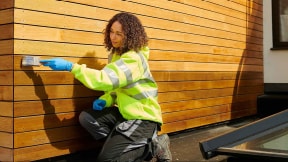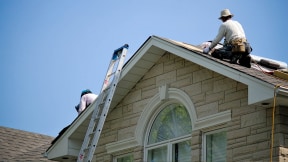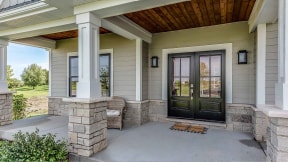Eco-friendly flooring: Options, pros and cons, and more

While air pollution is a commonly regarded issue in conversations surrounding climate change, you may be surprised to hear that indoor air pollution is typically two to five times higher than outdoor pollution levels.ec-epa-air-quality-2023
Though this number may be intimidating, there are ways to reduce what toxins you invite into your home. For example, you can opt for eco-friendly flooring. There are many sustainable flooring options that may help you reduce your carbon footprint and minimize health risks caused by toxins in your home.
What is eco-friendly flooring?
Similar to the practice of green architecture, eco-friendly flooring is an umbrella term for flooring alternatives made from materials that take less energy to produce and often create less waste in the process. Because they’re typically derived from natural materials, they often contain fewer toxins.
Examples of sustainable flooring
Today, you can find many different types of green flooring options and treatments, such as:
Engineered hardwood flooring
If you’re a fan of hardwood flooring, there are eco-friendly options out there, too including some that are certified by the Forest Stewardship Council (FSC). The FSC is a United States organization dedicated to ensuring responsible foresting practices. They provide certifications that confirm which forest areas meet their criteria.ec-fsc-label-2024 You can find hardwood flooring companies that source and produce products from FSC-approved forests and benefit from this stamp of approval. Depending on the company, sustainable hardwood comes in different colors and textures.
Concrete flooring
In most cases, concrete is made from a combination of ingredients, including cement and natural ones, like gravel and water. Concrete’s composition makes it a fully recyclable, sustainable alternative for floors. When concrete gets demolished, it can be crushed and made anew for future projects.
Eco-friendly carpet
While the composition of many carpets may not be the best for the environment, there are eco-friendly options on the market, and due to the push for more sustainable materials, you can now find them at a more competitive price than you might have in the past. Eco-friendly carpets are sourced from natural materials and have little-to-no chemical treatment. You’ll also want to look out for the backing of the carpet, or the fibers that keep it all together with, ideally, natural fiber backings and minimally toxic adhesives.
Bamboo flooring
Bamboo is an eco-friendly flooring alternative (often used in place of hardwood) due to its fast-growing, regenerative and carbon-absorbing properties. It’s known to be a hard, durable surface compared to other plant derivatives.
Carpet seal
Carpet seal is a low-cost, agile option for homeowners looking to make an environmentally friendly choice for their floors. There are non-toxic, eco-friendly carpet seals on the market meant for synthetic carpets. The seal prevents toxins from chemically treated carpets from emitting into the air and may also help protect against stains. Do note that carpet seals may not work for all fabric, so be sure to do some research before applying any product to your carpet.
Should you invest in environmentally friendly flooring?
If you’re on the fence about sustainable flooring, you’re not the only one. As a homeowner, a decision that's both pragmatic and aesthetic carries a lot of weight. Let’s explore some pros and cons surrounding sustainable flooring that may help inch you toward a decision.
Pros of eco-friendly floors
- The way they are sourced, produced and installed makes them more energy-efficient and better for the environment.
- Depending on what material you choose, they may be of better quality and last longer.
- They’ll likely reduce the level of toxins inside your home.
Cons of eco-friendly floors
- They may be more expensive alternatives.
- There may be less to choose from (limited colors and textures, for example) due to the amount of time it takes to develop and engineer these newer, eco-friendly alternatives – however, the market has improved over time.
- While technology has improved, they may be more susceptible to moisture damage or sun-fade due to their natural composition. However, some people may appreciate a potentially rustic home style.
In summary
Whether you’re refinancing for a home renovationec-refinance-hl000061 or looking to make a change, sustainable flooring may be something worth considering. Eco-friendly floors are an environmentally friendly (and potentially healthier) way to enhance your home. There are many sustainable flooring options out there made from natural materials like bamboo or regenerative wood sourced from FSC-approved forests. If you aren’t looking to replace your floor or invest in something unfamiliar, you can even opt for a carpet seal that helps prevent air pollution from synthetic fibers.



